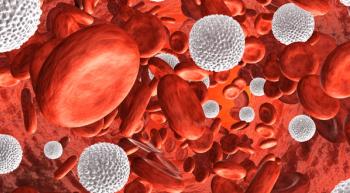
Goodman Highlights Potential Benefit of SBRT in Locally Advanced Pancreatic Cancer
Karyn A. Goodman, MD, MS, provides perspective on the potential advantages of stereotactic body radiation therapy in locally advanced pancreatic cancer.
Stereotactic body radiation therapy (SBRT) may present a more tolerable option for patients with locally advanced pancreatic cancer than intensity-modulated radiation therapy (IMRT), according to Karyn A. Goodman, MD, MS, who added that the 2 have similar efficacy profiles.1
“For patients with pancreatic cancer, SBRT is a really nice option,” Goodman, professor and vice chair for research and quality in the Department of Radiation Oncology at the Icahn School of Medicine at Mount Sinai, and associate director for Clinical Research at The Tisch Cancer Institute at Mount Sinai told Oncology Nursing News®. “It minimizes the amount of time patients have to be in the hospital for their radiation—it’s only 5 treatments, usually, given over [approximately] 2 weeks. It’s a very focal radiation delivery process; we’re only treating the primary tumor and maybe some adjacent nodes that are enlarged, rather than [the] larger field that we use for the standard chemoradiation.”
“It is very well tolerated and patients have minimal toxicity from the treatment,” she noted.
Goodman is one of the authors on the phase 3 TIGeR-PaC trial (NCT03257033), which is investigating the efficacy of intra-arterial chemotherapy administered via a dual-balloon catheter vs current standard of care. As part of the trial design, patients undergo radiation therapy during the indication phase. Data from this phase allowed investigators to assess the toxicity and efficacy rates between the 2 radiotherapy methods.1
Although the study was not designed as a head-to-head comparison of SBRT compared with IMRT, the data suggest that SBRT may be a more tolerable treatment strategy and elicits similar efficacy outcomes as IMRT. The findings showed that no significant differences in local tumors responses were recorded between SBRT and IMRT. At the same time, fewer patients needed to withdraw from the study because of a serious adverse event (SAE) with SBRT than with IMRT.
The trial included 134 patients from 22 different sites, 75 of whom received IMRT and 59 of whom underwent SBRT. The rates of any adverse event (AE) with IMRT or SBRT, respectively, were 65.3% vs 44.1% (P = .015). The rates of gastrointestinal AEs were 44.0% vs 16.9% (P = .001) and the rates of grade 3 or worse AEs were 26.7% vs 10.2% (P = .026). Moreover, 10 SAEs (13.3%) were reported in the IMRT arm, as opposed to 2 in the SBRT arm (3.4%). During the study there was 1 death with IMRT and none with SBRT. Ultimately, 9 patients (12.0%) on IMRT withdrew from the study vs 1 on the SBRT arm (1.7%; P = .042).
Moreover, the mean CA 19-9 change was not significantly different between IMRT and SBRT recipients (P = .262). In terms of tumor size, the mean change was –11.7% with IMRT and –12.6% with SBRT (P = .792).
Locally advanced pancreatic cancer is a deadly cancer for which radiotherapy is considered standard management.2 Despite this, the optimal RT technique has yet to be determined. Both SBRT and IMRT represent common treatment approaches. Although the study authors concluded that further prospective studies are needed to address the optimal radiation modality, the findings from this research suggest that SBRT may be the best radiation backbone for novel therapies, such as intra-arterial chemotherapy.1
“This was a nice opportunity to evaluate 2 different ways of delivering radiation for patients with locally advanced pancreatic cancer,” Goodman concluded.
References
- Goodman KA, Pishvaian, Lopez CD, et al. Toxicity and efficacy of stereotactic body radiation therapy vs intensity-modulated radiation therapy for the treatment of locally advanced pancreatic cancer in a phase 3 trial. J Clin Oncol. 2023;40(suppl 4):713. doi:10.1200/JCO.2023.41.4_suppl.713
- National Comprehensive Cancer Network. Clinical Practice Guidelines in Oncology. Pancreatic adenocarcinoma, version 2.2022. Accessed February 23, 2023.
https://www.nccn.org/professionals/physician_gls/pdf/pancreatic.pdf
Newsletter
Knowledge is power. Don’t miss the most recent breakthroughs in cancer care.
















































































